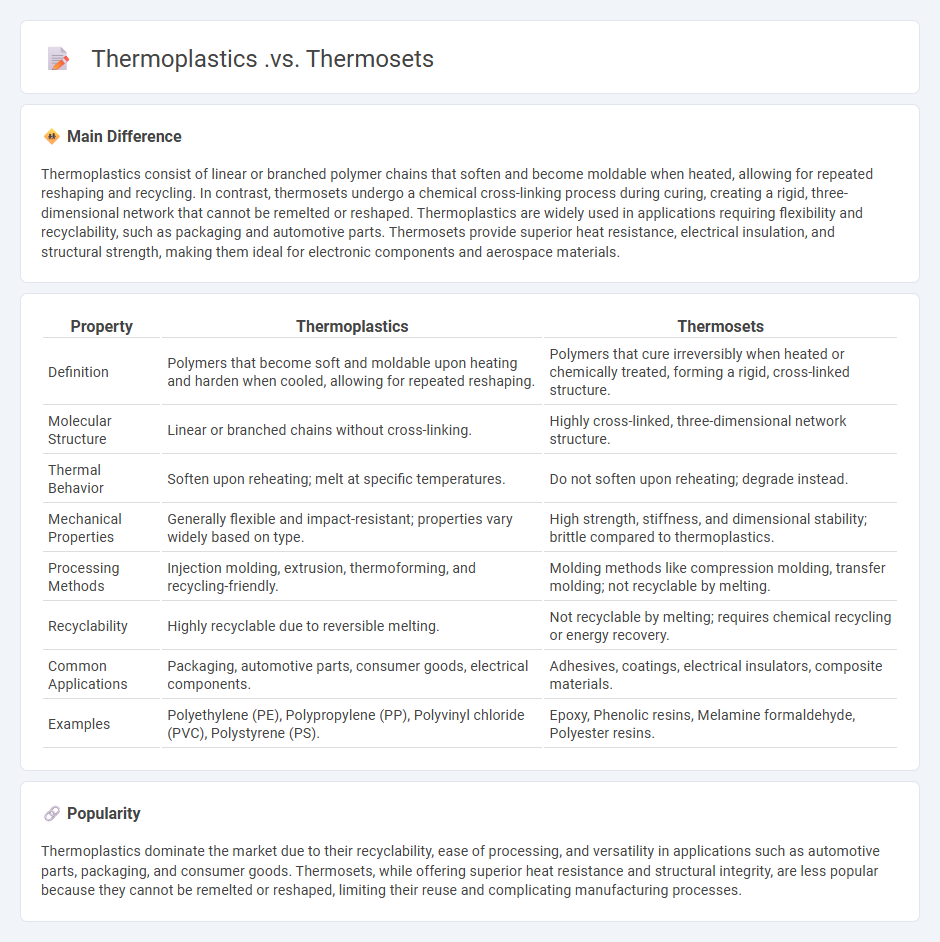
Thermoplastics soften when heated and can be reshaped multiple times, making them ideal for applications requiring recyclability and flexibility. Thermosets, on the other hand, undergo a curing process that creates a rigid, cross-linked structure, providing superior heat resistance and mechanical strength. Explore the key differences between thermoplastics and thermosets to determine the best material for your specific engineering or manufacturing needs.
Main Difference
Thermoplastics consist of linear or branched polymer chains that soften and become moldable when heated, allowing for repeated reshaping and recycling. In contrast, thermosets undergo a chemical cross-linking process during curing, creating a rigid, three-dimensional network that cannot be remelted or reshaped. Thermoplastics are widely used in applications requiring flexibility and recyclability, such as packaging and automotive parts. Thermosets provide superior heat resistance, electrical insulation, and structural strength, making them ideal for electronic components and aerospace materials.
Connection
Thermoplastics and thermosets both serve essential roles in polymer science, differentiated primarily by their molecular structure and thermal behavior. Thermoplastics consist of linear or branched polymers that soften and reshape upon heating, allowing for recycling and reprocessing, while thermosets form cross-linked networks that harden irreversibly when cured, providing superior structural integrity and heat resistance. This fundamental distinction connects them in applications where design requirements dictate whether flexibility and recyclability or durability and thermal stability are paramount.
Comparison Table
| Property | Thermoplastics | Thermosets |
|---|---|---|
| Definition | Polymers that become soft and moldable upon heating and harden when cooled, allowing for repeated reshaping. | Polymers that cure irreversibly when heated or chemically treated, forming a rigid, cross-linked structure. |
| Molecular Structure | Linear or branched chains without cross-linking. | Highly cross-linked, three-dimensional network structure. |
| Thermal Behavior | Soften upon reheating; melt at specific temperatures. | Do not soften upon reheating; degrade instead. |
| Mechanical Properties | Generally flexible and impact-resistant; properties vary widely based on type. | High strength, stiffness, and dimensional stability; brittle compared to thermoplastics. |
| Processing Methods | Injection molding, extrusion, thermoforming, and recycling-friendly. | Molding methods like compression molding, transfer molding; not recyclable by melting. |
| Recyclability | Highly recyclable due to reversible melting. | Not recyclable by melting; requires chemical recycling or energy recovery. |
| Common Applications | Packaging, automotive parts, consumer goods, electrical components. | Adhesives, coatings, electrical insulators, composite materials. |
| Examples | Polyethylene (PE), Polypropylene (PP), Polyvinyl chloride (PVC), Polystyrene (PS). | Epoxy, Phenolic resins, Melamine formaldehyde, Polyester resins. |
Molecular Structure
Molecular structure defines the three-dimensional arrangement of atoms within a molecule, crucial for engineering disciplines such as materials science and chemical engineering. Understanding molecular structure enables the design of advanced polymers, nanomaterials, and pharmaceuticals with tailored properties. Techniques like X-ray crystallography and nuclear magnetic resonance (NMR) spectroscopy provide precise molecular structural data critical for computational modeling and simulation in engineering applications. Molecular structure directly influences mechanical strength, thermal stability, and chemical reactivity, driving innovation in engineering materials and processes.
Processing Temperature
Processing temperature significantly influences material properties such as viscosity, crystallinity, and phase transitions in engineering applications. Precise control of processing temperature ensures optimal mechanical strength, durability, and performance of polymers, metals, and composites. For instance, injection molding of polypropylene typically occurs between 220degC and 250degC to achieve desired melt flow characteristics. In metallurgy, the heat treatment temperature ranges between 800degC and 1300degC to refine grain structure and enhance hardness.
Mechanical Properties
Mechanical properties define a material's response to applied forces, including tensile strength, hardness, ductility, and elasticity. These properties are critical for selecting materials in engineering applications such as construction, automotive manufacturing, and aerospace design. Engineers analyze stress-strain behavior using standardized tests like tensile testing and Charpy impact tests to determine performance under load. Advanced materials such as carbon fiber composites and high-strength alloys offer enhanced mechanical properties for specialized engineering demands.
Recyclability
Recyclability in engineering focuses on designing materials and products for efficient recovery and reuse at the end of their lifecycle. Engineers prioritize selecting recyclable metals, polymers, and composites that maintain structural integrity while enabling effective sorting and processing. Advanced techniques such as modular design and standardized components improve disassembly and material separation, reducing environmental impact. Incorporating recyclability into engineering supports sustainable manufacturing practices and aligns with circular economy principles.
Application Suitability
Application suitability in engineering evaluates how well a material, process, or technology meets the specific requirements of an engineering project. Factors such as mechanical properties, environmental resistance, cost-effectiveness, and compatibility with existing systems determine the appropriateness of a solution. Engineers conduct rigorous testing, simulation, and analysis to ensure that the selected components perform reliably under expected operating conditions. Optimizing application suitability reduces failure risks and enhances overall system efficiency and longevity.
Source and External Links
Thermoset vs Thermoplastic: What's the Difference? - Thermosets form permanent, irreversible chemical bonds when heated, making them strong and heat-resistant but impossible to remould or recycle, while thermoplastics can be repeatedly melted and reshaped without chemical change, offering recyclability but less heat resistance.
Thermoset vs Thermoplastic: Definition, and Differences - Thermosets excel in high-temperature, high-strength applications and resist reshaping, whereas thermoplastics are valued for their remouldability, impact resistance, and recyclability, though they may soften under heat.
Thermoset vs. Thermoplastic | Composite One Blog - Once cured by heat, thermoset plastics cannot be remelted or remoulded, offering durability and stability for demanding uses; thermoplastics, in contrast, soften when heated and harden when cooled, allowing for multiple processing cycles without altering their chemical structure.
 calledges.com
calledges.com